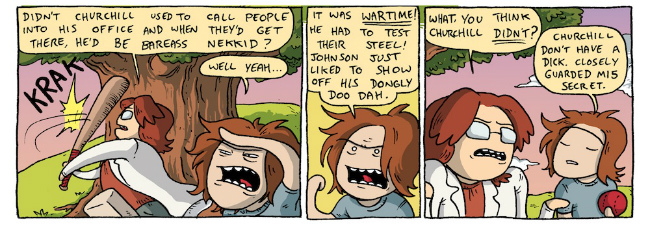 Gary Clap and Kirk Campbell’s Dirty Rotten Comics is a small press anthology that champions creators of all levels of technical ability and experience, from established names in UK comics through to newbie comickers getting their very first opportunity at reaching a wider audience. Earlier this year I reviewed the third issue of DRC here in ‘Small Pressganged’ describing the book as “a laudable exercise and an invaluable platform for the disenfranchised would-be practitioner.”
Gary Clap and Kirk Campbell’s Dirty Rotten Comics is a small press anthology that champions creators of all levels of technical ability and experience, from established names in UK comics through to newbie comickers getting their very first opportunity at reaching a wider audience. Earlier this year I reviewed the third issue of DRC here in ‘Small Pressganged’ describing the book as “a laudable exercise and an invaluable platform for the disenfranchised would-be practitioner.”
This week the latest edition of Dirty Rotten Comics is launched featuring names familiar to ‘Small Pressganged’ readers of the likes of David Ziggy Greene, Elizabeth Querstret, Tim Bird, Claude TC (see banner image above) and Danny Noble, alongside a whole host of new talent to be discovered for the first time. I caught up with the DRC editorial team to ask them about the anthology’s origins, their inclusive philosophy, and just what we can expect to see in the giant-sized, near 100-page fourth issue…
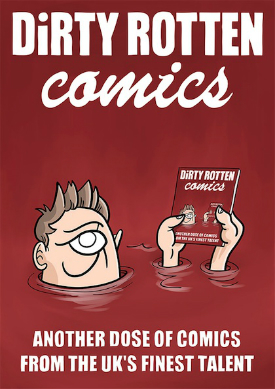 ANDY OLIVER: As the showrunners behind Dirty Rotten Comics can we begin with a short recap of the “secret origin” of the anthology? How did you meet and what was the genesis of the project?
ANDY OLIVER: As the showrunners behind Dirty Rotten Comics can we begin with a short recap of the “secret origin” of the anthology? How did you meet and what was the genesis of the project?
GARY CLAP: Kirk and I met at university ten years ago, where we wrote together for student radio. We dabbled with various self-published projects with varying degrees of success before working on the first two issues of Dirty Rotten Comics in 2010. Over the next few years we continued writing together, and started submitting strips to comic anthologies but had no luck getting printed.
Through conversations with other artists we began to realise there were a lot of people in similar positions – there was a lot of great content out there but not enough platforms to promote it. The few anthologies that did exist seemed to either represent closed collectives or prioritised work by the bigger names in the scene at the expense of lesser-known talent. It felt like there was a big gap for an anthology which was accommodating and inclusive, so in 2014 we revisited the Dirty Rotten Comics idea and decided to open our third issue up to submissions.
There’s a very distinctive philosophy behind Dirty Rotten Comics. How would you summarise your mission statement?
KIRK CAMPBELL: I don’t want to get all philosophical on you, quoting ‘schools of thought’ we subscribe to or auteurs that have influenced our own shaping of a ‘vision’. Put simply, we want to put together really cool books that show off a range of talented people’s work. Pushing that a bit further, our philosophy is all about supporting small press artists from the UK who have something pertinent to say. We realise that is a very open statement, but therein lies the appeal. There’s no driving force other than that.
A sample of Emily Rose Lambert’s contribution to DRC #4
I heard a great quote a few years ago from the manager of a few local grime artists. He said “don’t make the cemetery any richer than it already is.” We can pretty much guarantee that no one has ever heard the best song; laughed at the funniest joke; got teary at the most beautiful of poetry. No one has ever read the world’s greatest book. That’s because the most creative or talented people don’t necessarily get past the first few hurdles and therefore never get to express themselves fully. I think the comics scene is no different. If Gary and I help to change that in any small way, then Dirty Rotten Comics has been a success.
One of the big draws of Dirty Rotten Comics for me is its sense of inclusivity. Accomplished names sit next to obvious newcomers. It emphasises one of comics’ unique properties to me – that you don’t necessarily have to be a technically accomplished artist to create work that is a valid use of the form. Was that sense of democracy one of the most important factors to you when approaching DRC?
CAMPBELL: It was the factor that appealed most to us. I love a great, throw-away joke; a pun or a quip that you can read, laugh at and move on from. I also love something that is beautiful to look at, painstakingly crafted in micro-detail. Often, I’m in the mood for something that is text-heavy with a real sense of character, even if that character is a little bit boss-eyed. Hell, I don’t think I’ve ever (like, ever) managed to draw a person that isn’t wonky or boss-eyed but I feel like I can write strips people will really ‘get’. I can safely say we have got each of those forms and more in issue #4 which is pretty damn cool.
Pete Shearn’s offering from #4 of the anthology
There’s no part of our editorial process where we go “hmmm, but who is it by?” Sure, I have on occasion done a schoolgirl hyper-mini handclap when we get a submission through from someone I have a great fanboy respect for. But quite honestly whoever it’s by, if the strip works, the strip works. So let’s get it out there and see if other people like it too.
Could you tell us a little about your own comics practice outside of Dirty Rotten Comics?
CLAP: Kirk and I are both big fans of the ‘six minute comics’ method, whereby we draw a four panel comic within a six minute time frame. It’s a great system for generating new ideas, and we do it as a group whenever we meet for our Beer and Comics social in London. The best of these we upload to our website or use as a catalyst for other ideas.
In terms of personal projects, I’ve been working on the surreal webcomic Yummy Fish since January 2014. It’s taken a bit of a back-seat as I’ve been working on Dirty Rotten Comics, but I hope to get back to it in the near future. I’m conscious of not letting my comics work suffer, however, and am pleased to say I managed to get a strip turned around in time for inclusion in issue #4!
An example of Gary’s ‘Yummyfish’ strip above
Four issues in, how steep a learning curve has the experience of putting together an anthology been? What have been the major pitfalls along the way?
CAMPBELL: There have been many late nights and a few hair-raising panics to reach deadlines over the course of our partnership, but I don’t think these can ever be avoided in the early stages of any project and so we’ve learnt just to ride these times out knowing that things always come together in the end if you’re committed enough. I certainly couldn’t provide you with any new information that would benefit a ‘101 must-know tips for producing a small press comic’ guidebook. However, we’ve each learnt a lot about our individual perfectionist streaks over the past 6 years of working together and getting to that stage where you each know when to push and when to pull is what has really been our most important discovery as editors.
As a result, I feel we have really got into the groove with this fourth one; we have a clear direction, aim and design for the anthology and honestly can’t wait to see it grow. Therein lies the main tension we have experienced- learning to not get ahead of yourself, take things step by step, do the simple things properly, remain calm and clear in your endeavours. The rest will come.
Work in DRC #4 from Jason Mathis, Tom Scotcher and James Wragg
The fourth issue debuts this week. What familiar names can we expect to see in issue #4?
CLAP: We are really pleased to include Matthew Dooley, Elizabeth Querstret, Jey Levang and Claude TC, who all contributed to our previous issue and have provided some fantastic new strips for issue #4. Alongside a wealth of newer names, those that may be more familiar to your audience include Tim Bird (Grey Area, Avery Hill), David Ziggy Greene (Scene and Heard, Private Eye) and the writer/artist partnership of Barney Farmer and Lee Healey (‘Drunken Bakers’, Viz).
Are there any newer creative voices we should especially be looking out for in #4? And is there anyone from the previous issue who you particularly feel hasn’t had the recognition yet that they deserve?
CLAP: The quality of submissions this time around has been exceptional. Stand outs for me include Ioan Morris of Dry Comics, who has a pitch-black sense of humour and provided us with one of the issue’s most poignant strips. Keep a look out for Kevin Loftus also, whose style reminds me of early Robert Crumb. Kevin’s strip ‘Butt Dialled’ is dark and a little unhinged, and I hope we see more from him in the future.
Samples from #4 of the work of Kevin Loftus (left) and Jay Levang (right)
Likewise, Sarah Crosby is another new name I’m expecting big things from. Her piece ‘The Job Centre’ is in turns both cutting and insightful, and is complimented well by light and cartoony artwork. James Wragg was also a new name to us. He has a lovely, graphic style of drawing, which brings to mind Mike Mignola and Jamie Hewlett. James’ strip ‘Afterlife’ is a witty meditation on death, and closes out issue #4 .
We were really excited to see the attention that Jess Milton received after our last anthology [BF note: Jess Milton is one of our ‘Six UK Small Press Creators to Watch in 2015’]. We don’t have anything from Jess in issue #4, but Jey Levang is a returning artist that we hope will receive more recognition in the future. Jey’s work is fluid and illustrative, and they have an excellent grasp on storytelling. If you liked her piece in our last anthology, you’ll definitely enjoy her contribution to issue #4!
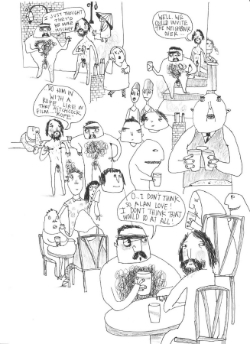 I can’t talk about Dirty Rotten Comics #4 without mentioning the involvement of Danny Noble, another one of my Small Pressganged ‘Six Small Press Creators to Watch in 2015’. What can you say at this point about her contribution to #4 (see right)?
I can’t talk about Dirty Rotten Comics #4 without mentioning the involvement of Danny Noble, another one of my Small Pressganged ‘Six Small Press Creators to Watch in 2015’. What can you say at this point about her contribution to #4 (see right)?
CAMPBELL: That it’s exactly what you would expect. We’ve put on our theorist’s caps (beret, probably) and analysed the symmetry of her page content, the emotion in the flow of lines from panel to panel, the intertexuality of the macro elements and concluded that it’s another winner. Also, it’s bloody funny.
How do aspiring contributors submit to Dirty Rotten Comics and when will your next issue be published?
CLAP: Submissions typically open shortly after the previous issue is released, and we’ll announce it on our website and Twitter once this happens. However, we always love to hear from aspiring contributors, so would encourage people to get in touch if they have a strip or idea they’d like us to look at. We have more information on our website about what we’re generally looking for, but broadly speaking the sky is the limit!
As for our next issue, we’ll be announcing more information soon so make sure to keep an eye on our website and Twitter.
With issue #4 being such a bumper issue in terms of page count where do you see Dirty Rotten Comics going next?
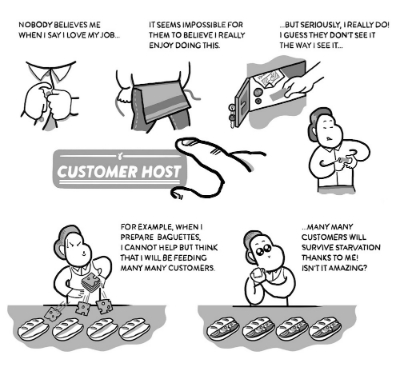 CAMPBELL: We’ll take things at a pace we feel comfortable with, and try to keep growing the number of people that both submit to and buy each issue through sticking to our guns and producing high-quality work. We certainly don’t intend to slow down any time soon but need to make sure we’re doing the right thing issue by issue, so whether the page numbers will continue to increase at an exponential rate or whether we release more issues in a year is something we need to address fairly soon. Maybe the right formula will be found through trial and error over the next 12 months, but we’re pretty clear on where we want to get to in the medium to long term- an anthology that is still inclusive and eclectic in the best possible way.
CAMPBELL: We’ll take things at a pace we feel comfortable with, and try to keep growing the number of people that both submit to and buy each issue through sticking to our guns and producing high-quality work. We certainly don’t intend to slow down any time soon but need to make sure we’re doing the right thing issue by issue, so whether the page numbers will continue to increase at an exponential rate or whether we release more issues in a year is something we need to address fairly soon. Maybe the right formula will be found through trial and error over the next 12 months, but we’re pretty clear on where we want to get to in the medium to long term- an anthology that is still inclusive and eclectic in the best possible way.
And, finally, what shows and festivals can our readers catch up with you at in 2015?
CLAP: We will be appearing at the Alternative Press Takeover and DIY Cultures Fair in May, where we’ll be debuting issue #4. Looking beyond these, we’d love to do some more shows over the summer and autumn but can’t guarantee anything at this point. We always announce details of upcoming appearances on our website and Twitter, so make sure to keep your eyes peeled!
You can order copies of Dirty Rotten Comics #3 and #4 from the DRC online store here and visit their website here for more details on the anthology. You can also follow Dirty Rotten Comics on Twitter here.
For regular updates on all things small press follow Andy Oliver on Twitter here.





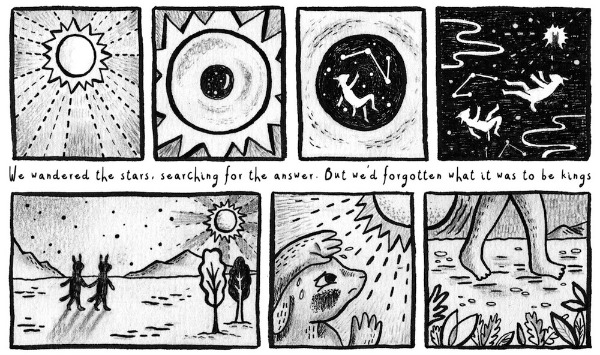
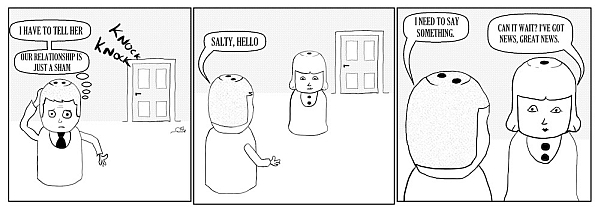

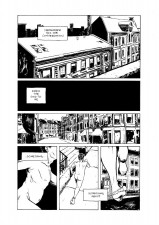
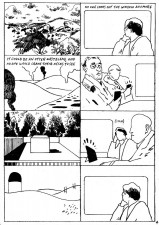
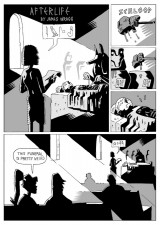
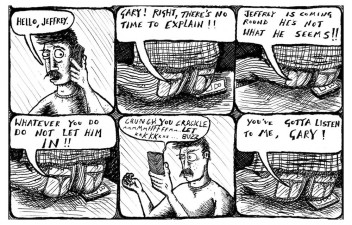
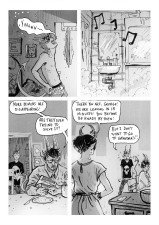

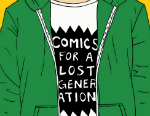
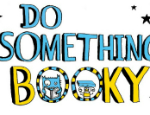
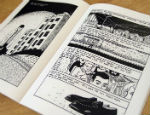
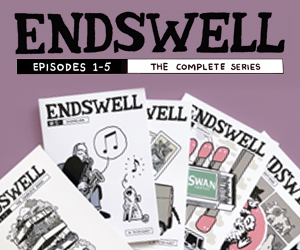
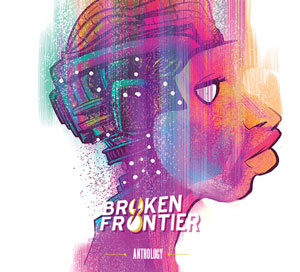
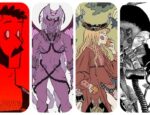
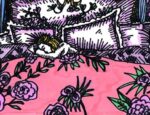
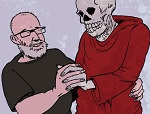
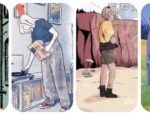
[…] You can read Andy’s full interview with Kirk and myself here. It gives a little more insight into the origins of Dirty Rotten Comics, our driving philosophy, thoughts on the latest issue, and our hopes for the future of the project. […]
[…] In the media: Down The Tubes, Broken Frontier. […]
[…] Na mídia: Down The Tubes, Broken Frontier. […]
[…] Rotten Comics by the Patron Saint of Small Press Andy Oliver from the church of Broken Frontier (interview here). Previous artists to contribute include the athletic table-clamberer Danny Noble, and Jess Milton, […]
[…] you delightful readers know when so you can go and support such a fantastic anthology. Read the Broken Frontier Small Press Spotlight on Dirty Rotten Comics from last year to find out all about the DRC philosophy and what makes it so special, and read all […]